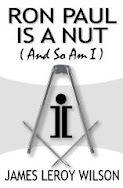That said, much of the arguments for the "separation of Church and State" are made by people who a) hate the Church and b) LOVE LOVE LOVE the State. They believe any governmental "establishment of religion" will lead to war. Many of them think religion is the cause of all wars.
This ignorant belief is worse than useless. The secular Statist has proven himself, via his retrograde ethics, far worse than the Puritan. The secular Statist believes in b.s. like "mandatory minimum sentences" for non-violent drug dealers and economic sanctions on already poor and helpless countries.
Secularists, NOT religionists, are responsible for all of America's wars of the past two hundred years, and perhaps of all wars in that period. Since the War of 1812, there was never a war in which...
- America's security threatened, or
- religious values were at stake.
Also, in the past two centuries, it was ideology -STATISM-, not religion, that fueled Nationalism, Communism, Fascism, and Naziism.
My frustration with the sanctimonious b.s. from secular statist ideologues found relief through Joseph Stromberg's review of William T. Cavanaugh's book The Myth of Religious Violence: Secular Ideology and the Roots of Modern Conflict from the Independent Institute.
Stromberg quotes Cavanaugh:
“There is no reason to suppose that so-called secular ideologies such asAnd then Stromberg says...
nationalism, patriotism, capitalism, Marxism, and liberalism are any less prone to be
absolutist, divisive, and irrational than belief in, for example, the biblical God”
Cavanaugh notes that...
the Catholic Holy Roman emperor Charles V fought the pope, not the Lutherans.
The pope opposed the emperor. Officially Catholic France opposed the officially
Catholic emperor. France sided with the Turks against the empire, and Protestant
princes supported it. Catholic Bavarians opposed the empire. The pope opposed
Catholic king of Spain Philip II. French internal strife displayed shifting alliances
between particular Catholic factions and Huguenots. Lutherans did not fight
Calvinists, despite their many differences. Here we meet with Cavanaugh’s most
striking exercise in demolition—at length (pages 142–50) and well supported.
Religion as primary cause ought to have pitted principled Catholic and
Protestant blocs against one another. The record does not show such a pattern.
The key conflict was between French and Habsburg state interests; hence,
these armed conflicts were not wars “of religion.” There is, as Cavanaugh notes,
the further problem of specifying which motives count as “religious.” If Emile
Durkheim was right, we simply cannot separate the social from the religious. In
these wars, states imposed national unity, including the state’s preferred (and
controlled) church. In Cavanaugh’s view, state-led confessionalism was part of
building an obedient populace.
Instead of the modern state as the solution to wars caused by religion,
Cavanaugh offers a “shift to state dominance over the church” (p. 161). This shift
was a cause, not a cure, of the wars and was closely allied with the “invention of
sovereignty.” The wars were among the “birth pangs of the state.” Building on the
work of Charles Tilly, Hendrik Spruyt, Perry Anderson, Otto Hintze, Antony
Giddens, Michael Mann, and Michael Howard, Cavanaugh finds the causes of the
General Crisis of the seventeenth century and the accompanying wars precisely in
territorial states’ drive to increase and centralize political power. This drive provoked
regional resistance that involved local elites, peasants, and other classes, and this
resistance cut across religious lines. Cavanaugh concludes that state-building projects
were in fact “a principal cause of the wars in question” (pp. 177–78).
After this famous victory for the state (not for tolerance as an end), a subject’s
primary obligation was to the mystical body of the state. The state was sacralized, not
secularized. The result was a new form of salvation in which death for the state is
never in vain. Thus, sacrifice “provides the glue that binds a liberal social order
together” (p. 179)
In brief, the State isn't founded on "law" or "morality," but on loot.




No comments:
Post a Comment